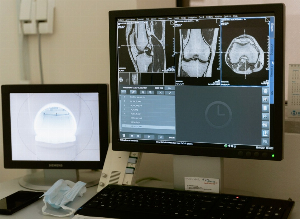Osteoarthritis and nutrition: How to relieve joint pain?
Published Oct 25, 2021 • By Claudia Lima
Osteoarthritis affects more than 500 million people worldwide, and more than 32.5 million people in the United States. Often a change in diet is recommended to relieve painful joints.
Which foods should be avoided? Which foods should be prioritized?
Read our article to learn more!

What is osteoarthritis?
Osteoarthritis is a chronic illness affecting the cartilage and the adjacent tissues. Its is characterised by pain, stiffness and loss of motion.
Cartilage loss can occur slowly over several years, there may be phases of aggravation called flare-ups, and there is a form of cartilage destruction that can develop very quickly, within one to two years.
All joints can be affected. Osteoarthritis can occur in multiple places in the body, and most often affects:
- The spine, in the cervical or lumbar vertebrae,
- The knees (called gonarthritis),
- The hips (called coxarthritis, or osteoarthritis of the hip),
- The wrist,
- The thumb (called rhizarthrosis or osteoarthritis of the thumb),
- The fingers, (called digital osteoarthritis).
Other, less common forms of arthritis affect the shoulders, elbows, ankles, etc.
Osteoarthritis is the most common joint disease, and its prevalence is predicted to increase in the coming years, due to the increase in life expectancy and the number of overweight and obese people.
OA is often confused with arthritis, a general term that encompasses any form of tissue inflammation, whether acute or chronic, that may affect one or more joints. There are more than a hundred different arthritic conditions such as bursitis, tendonitis, psoriatic arthritis, fibromyalgia, osteoarthritis, rheumatoid arthritis.
What causes ostoarthritis and how is it treated ?
Osteoarthritis can be caused by several factors: a genetic predisposition, poor mechanical conditions that contribute to cartilage damage, such as small repeated traumas (eg: very intense physical activity) or repetitive movements in a professional setting.
Certain diseases can also be linked to osteoarthritis development: diabetes, obesity, Wilson's disease, etc.However, certain risk factors can be avoided, such as being overweight, smoking, poor posture,and lack of regular physical activity.
As for the treatment for osteoarthritis, no medication currently able to cure it. However, it is possible to slow the progression of the osteoarthritis and improve joint comfort. Rheumatologists recommend taking anti-inflammatory drugs when the affected joint is too painful.
To date, the treatment of osteoarthritis is essentially based on lifestyle and dietary measures to provide patients with lasting relief. One of the main recommendations is physical activity, tailored to physical abilities of each patient.
To a certain extent, diet can help to treat osteoarthritis, but there are many misconceptions circulating about the effects of, for example, dairy products and gluten, which are thought to worsen joint pain, with no scientific evidence to prove it.
What foods should be avoided if you have osteoarthritis?
Certain categories of food are known to increase inflammatory compounds in the body, and exacerbate arthritis pain. It is therefore necessary to limit foods that will cause inflammation and blood sugar spikes:
- Foods rich in saturated fatty acids (red meat, cheese, etc.),
- Foods rich in trans-fatty acids (processed and fried foods),
- Refined foods (white bread, white flour, etc.),
- Foods too rich in omega-6 (safflower, sunflower, soybean, and corn oils),
- Quick-sugar foods (cand, sweet desserts, etc.),
- Alcohol and soft drinks.
Milk, yogurts and cheese have a reputation for being pro-inflammatory and so some osteoarthritis patients prefer to avoid them. However, according to specialists, dairy products, which are rich in calcium and other nutrients, are still essential for healthy bones, muscles and joints.
Some people try restrictive diets, such as the Seignalet diet, in an attempt to limit osteoarthritis. There is no scientific evidence that an exclusionary diet improves or prevents the development of osteoarthritis.
What recommendations for osteoarthritis patients?
The two most important recommendations are regular physical activity and maintaining or losing weight.
It is strongly recommended to engage in regular physical activity in order to maintain muscle tone and thus protect the joints, such as the knees, for example.
It is important to maintain a "normal" weight (BMI between 18.5 and 24.9 kg/m2); if you are overweight, losing 4 to 5 kilos can be enough to relieve osteoarthritis. The effect is both mechanical and physiological. In overweight people, the adipose tissue secretes mediators that increase sensitivity to pain, as well as pro-inflammatory molecules that only aggravate the joint damage. To maintain or lose weight, it is essential to follow a balanced diet, which helps to avoid deficiencies.
Foods that can help osteoarthritis include:
- Garlic, thanks to its anti-inflammatory properties,
- Oily fish, walnut, soybean and canola oils, which are rich in omega-3s,
- Raw vegetables, which are excellent sources of water and vitamin C. Cartilage is structured by collagen fibres, a protein that requires this vitamin for its production,
- Parsley and fresh fruit (especially orange fruits), which are also rich in vitamin C and contribute to the production of collagen,
The Mediterranean diet is recommended by doctors because it helps maintain good health and protects cardiovascular system. In practice, meals following the Mediterranean diet contain foods that are known to be good for osteoarthritis patients, such as whole grains, fruit and vegetables, fish and olive oil.
Conversely, red meat, cold cuts and pre-prepared, processed foods should be limited. It is important to opt for gentle, low-temperature cooking and to avoid barbecues, frying, microwaves and other high-temperature cooking methods that generate Maillard molecules, which are toxic to cells, particularly those in the joints.
Hydration is also important, the most critical substance in the joint is cartilage, which is 75% water. It is important to drink sufficiently and regularly throughout the day.
A popular hypothesis recommends the use of probiotics through food supplements to restore the intestinal flora and thus limit the destruction of cartilage. Yogurts are a key source of probiotics for this purpose.
It is important to be careful with miracle foods and misconceptions. While some nutrients appear to be good for the joints, the scientific evidence behind these claims is very limited. Many doctors believe that there is no miracle diet to prevent osteoarthritis, arthritis or other joint diseases. The two main recommendations are, therefore, regular physical activity and/or a healthy diet if you are overweight.
Was this article helpful to you?
Give it a "like" and share your thoughts and questions with the community in the comments below!
Take care!
Sources:
Y'a-t-il des aliments à éviter en cas d'arthrose, Santemagazine.fr
Qu'est-ce qu'une articulation saine non touchée par l'arthrose, Arthrolink.com
Arthrose, qu'est-ce que c'est, Sante.lefigaro.fr
Arthrose : troubles osseux, articulaires et musculaires, Msdmanuals.com
Les aliments pour lutter contre l'arthrose, Notretemps.com
Journée mondiale de l'arthrose, Observatoire-sante.fr
Arthrose, les faux-amis de l'alimentation, Sante.lefigaro.fr
Osteoarthritis, cdc.gov

 Facebook
Facebook Twitter
Twitter


